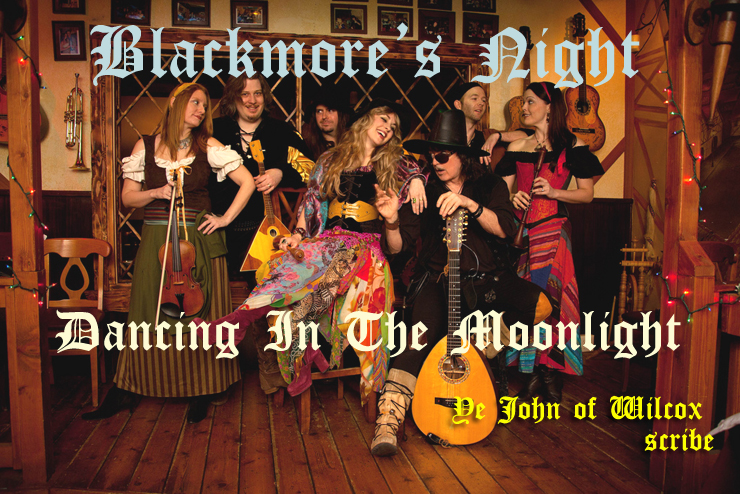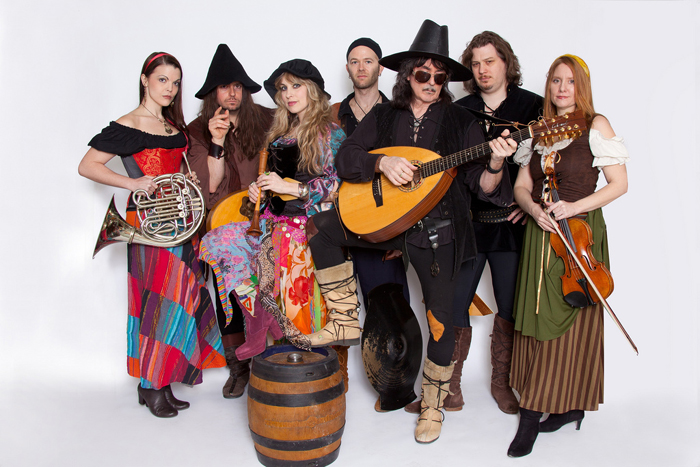Blackmore's Night - Dancing In The Moonlight
Ye John Of Wilcox, scribe

Dancer And The Moon is Blackmore's Night's 2013 studio follow up to 2010's Autumn Sky. As one has come to expect from the band, it's a Kellogg's variety pack, musically. New compositions, traditional tunes, and a clutch of instrumentals courtesy of Ritchie Blackmore, Candice Night, and their fellow minstrels.
The album opens with the beautiful I Think It's Going To Rain Today written by Randy Newman and originally a hit in 1966 for Julius La Rosa, of all people! Candice Night explains how it first came to the attention of the band: We had originally heard the Randy Newman song when we were watching Beaches. It's gotta be decades ago at this point - Bette Midler's brilliant version of that. We just thought that song was so enchanting. It actually became one of our favorites to do onstage. We would only play it on very special occasions.
Next is the exotic Troika, a strongly Eastern-tinged tale. It brings you vividly across Russian landscapes.
The Last Leaf is a fascinating tale, as Night elaborates: That's the one I'm really, really 100% proud of. Everything wound up the way I wanted it to be. It had the perfect parallel between human emotion and our own journey in life from the perspective of this leaf on the tree, and how it all came together. I'm really proud of that one.
It started because I have this big picture window in my kitchen. We live right on the water. There's this big old tree in between the house and the water. Every year at the beginning of Winter when the crazy winds kick up, because we live on the water, we get this vortex of winds that come through here. There's always one leaf that holds on to that tree and will not let go. It goes on well into the Winter, until we get the first snowfall. It's like it always wanted to hold on. I would look out the window for years and say "I'm going to write a story one day about that leaf. It's always the last leaf that will not let go, holding on so tight." Finally, when I heard Ritchie come up with this beautiful acoustic melody, I thought "Ah! Yes! It has a home!" I have to always wait until it fits perfectly.
A truly surprising re-invention of Uriah Heep's Lady In Black is next. Night once more: Ritchie's been a fan of Uriah Heep and he's known the guys for a long time. For some reason, he never knew Lady In Black. We were touring in Germany and every time we'd go over there they always had these infomercials all night long - :Hit songs of the seventies" or "Hit songs of the sixties" and this was one of the songs on there. Ritchie said "Who is that doing that song?" He even heard it on an old time radio station in one of the castles we were in. He was so familiar with other songs Uriah Heep had done, but he had never heard Lady In Black. We asked some of the fans and they said"Yes, of course, it's almost like an anthem over here." It's not one of those songs you hear a lot of people covering, even though it's such a great song. We added a little bit of medieval flair, a little bit of woodwinds.

Blackmore's skill is showcased on the timeless Minstrels In The Hall. It's an instrumental that will send you back several centuries.
A cover of the Rainbow classic Temple Of The King comes on the heels of Minstrels In The Hall. Night reveals: Temple Of The King is a great favorite of Ritchie's fans from the old days. Temple Of The King is one of those songs that people were like "Why don't you do this on a CD? We would love to hear it!" I think it was one of the first ways that people realized that Ritchie was involved with renaissance and medieval music, because it did have roots steeped in hundreds of years ago. Even back in the seventies when he was writing with Dio it was one of those songs where people said "Oh, maybe he's multidimensional here and goes back a few hundred years."
As a singer now, you never look back on those songs and go "OK, I'm gonna replace that version." I would never be so egotistical to say we're going to do it better. You almost approach it as a new song. We do it in such a different way. So you never step into the giant shoes of some of the other singers he's had, cos they're all brilliant in their own right and the songs are so strong and stand the test of time.
On to the title track - Dancer And The Moon! A true singalong, it was evidently a track that required a lot of work and patience according to Night: We redid that song so many times! Different keys, different arrangements, different instrumentation. Could not get it the way that we wanted to get it. For some reason it was just one of those ones where we had the lyrical content, we had the basic arrangement of the song. It just didn't feel like it fit right. We started with a big orchestral thing at the beginning. Then we just did renaissance woodwinds. No matter what we did we couldn't make it work. The basic skeletal idea of the structure of the song we knew was strong. We knew it definitely was something that could work, but it took a while to get to where we wanted it to get. It wasn't as natural as we would prefer a song to be in the creative aspect.
Blackmore's prowess as a player is once more in focus on the stately Galliard, a song as much at home in a castle's courtyard as at a ren faire!

Night explains the warm, nostalgic nature of The Ashgrove: That's originally an English folk tune. It was one of those songs that Ritchie used to play. Almost like Barbara Allen on the previous album. Ritchie's going back to his roots, to his schooldays, and bringing out some of these old traditional English songs that are very nostalgic for him at this point. He's lost a lot of people that were very important to him in this past year - obviously Jon Lord being one of him. He actually lived on a road called Ash Grove as well, when he was growing up. It was a source of comfort for him. It's a great old traditional English song. It's almost a true representation of how we play around the house. He'll bring a small amplifier and a small microphone with a tiny, tiny little bit of reverb and we'll just sit outside and play songs. It's the true heart and soul of Blackmore's Night.
Next are 2 companion pieces -- the ballad-y Somewhere Over The Sea (The Moon Is Shining) and the more modern, rhythmic The Moon Is Shining (Somewhere Over The Sea). Night gives insight to the surprisingly modern feel of the 2nd piece: The ballad side of that was the natural way that came out. Ritchie just felt that he really wanted to rock it up. He felt that it'd work with that kind of translation. They used a sequencer to beef it up as far as the tempo and the bass register. It tends to fill out that frequency a little bit more. Then they built on that as far as the production and the instrumentation was concerned. Then he was able to incorporate the electric guitar. Once he feels he has that driving force underneath him and that bass rhythm is filled up, that allows him to fly on the electric guitar.
Based on a melody by King Richard III, The Spinner's Tale is carried by a lilting vocal by Night and a sensitive arrangement by Blackmore.
The album ends on a melancholy note with the instrumental Carry On... Jon. It's a moving tribute to Blackmore's recently departed bandmate from his Deep Purple days - Jon Lord.
Dancer And The Moon is an album to engage your heart, mind, and feet. It has the depth of centuries married to minstrels of the present. Dance the whole night through. Nothing gets between the dancer and the moon!
###
Table Of Contents
Contact



